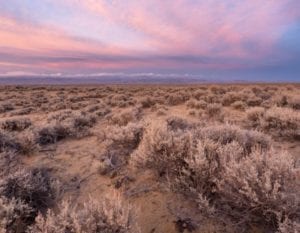Restoration
View article.
Invasive annual grasses, wildfire, and climate change are changing ecosystem processes in the sagebrush biome at a pace and scale requiring an assessment of where processes can be saved, where they can be regained, and where they are lost. Confronting these threats is the primary focus of restoration and management efforts, guiding policy creation, project prioritization, and action on the ground. The new Defend the Core framework helps land managers, landowners, and policy makers to use the tools or management actions most likely to improve conditions.
View article.
Collaborating at the planning stage of restoration projects can be slow. It takes time to build relationships, and meeting people “where they are at” is often the accomplishment. Success in collaboration comes from gathering the local knowledge to move forward with implementing projects. Long-standing collaborative groups often face challenges with keeping stakeholders and partners involved particularly when tracking past projects. Finding continued funding to maintain the projects implemented years earlier takes effort usually on behalf of the convening organization.
Who: This training course was developed in concert with Society for Ecological Restoration and BLM’s National Training Center. It is available to restoration practitioners within the DOI and our partners. Target Audience: Natural Resource Specialists, Fire, Fuels, Emergency Stabilization and Rehabilitation, Botanists, Wildlife Biologists, Ecologists, Range, Minerals, Mining and Reclamation
What: This self-paced on-line course is intended to serve as an introduction to seed technology and arid and semi-arid lands restoration as a first step towards more in-depth in person restoration and revegetation courses. It provides world-class training on restoring dry land ecosystems, which are critical resources in tackling the climate crisis. By the end of the course, participants will have an understanding of: Ecological restoration principles, standards of practice, and concepts to increase the success of restoration efforts, arid/semi-arid ecosystems and the challenges they pose to successful restoration, and how to apply ecological restoration best practices and concepts in restoration planning in arid and semi-arid ecosystems.
Where: Request an account here eDOI and search for: Arid and Semi-Arid Lands Seed Technology and Restoration.
The course consists of the following modules/lessons. Each are accessed separately and must be taken in sequential order.
Module 1: Introduction
Module 2: The National Seed Strategy
Module 3: Principles, Standards and Concepts
Lesson 3.1: Principles and Standards for the Practice of Ecological Restoration
Lesson 3.2: Principles, Standards and Concepts – Native Seed Standards
Module 4: Arid and Semi-Arid Systems
Lesson 4.1: Overview of Drylands
Lesson 4.2: Restoration Challenges
Lesson 4.3: Current Knowledge
Module 5: Developing and Implementing a Restoration Plan
Introduction
Lesson 5.1: Project Context
Lesson 5.2: Vision, Goals, and Objectives
Lesson 5.3: Plant Materials Selection and Procurement
Lesson 5.4: Site Preparation
Lesson 5.5: Developing and Implementing Seeding and Planting Strategies
Lesson 5.6: Monitoring and Management
Lesson 5.7: Putting It All Together
View article.
From following more than 1,500 wildfires, we find treatments were disproportionately applied in more stressful, degraded ecological conditions. Failure to incorporate unmeasured drivers of treatment allocation led to the conclusion that costly, widespread seedings were unsuccessful; however, after considering sources of bias, restoration positively affected sagebrush recovery. Treatment effects varied with climate, indicating prioritization criteria for interventions. Our findings revise the perspective that post-fire sagebrush seedings have been broadly unsuccessful and demonstrate how selection biases can pose substantive inferential hazards in observational studies of restoration efficacy and the development of restoration theory.
View article.
Local unburned reference communities had fewer herbaceous perennials and higher woody cover than NRCS reference communities, suggesting departure from conditions expected under minimal post-settlement disturbance. USCs became more similar to reference communities over time, though less so at a site with abundant invasive annuals. Trajectories of seeded treatments were driven by seed mix species, with native-only mixes approaching reference communities more closely than mixes with non-natives.
View brief.
This “A-Z guide” highlights recent Rocky Mountain Research Station (RMRS) science and covers methods to make biochar on site, including using piles, kilns, and air curtain burners. It also details three uses for biochar (agricultural, forest restoration, and mine land reclamation), and methods for application, including biochar spreaders.
View article.
This study assessed the attractiveness and use by bees of 24 native plant species that are standard for revegetation projects (focal plants) on national forest lands in western Montana. Focal plants that had the highest visitation rate, attracted the most bee species, supported specialist bee species, and bloomed for extended periods across the landscape were considered “pollinator-friendly.” Our results suggest that Salix bebbiana, Arctostaphylos uva-ursi, Lupinus sericeus, Rosa woodsii, Symphoricarpos albus, Erigeron speciosus, Symphyotrichum foliaceum, and Gaillardia aristata could create a seed mix that is effective for pollinator restoration on public lands. Pollinator-friendliness score cards are provided to allow land managers to select plant species to include in restoration mixes that benefit pollinators. Identifying mixes of pollinator-friendly native plant species that are available for restoration will allow land managers to both revegetate disturbed habitats and restore bee communities on federal lands. The methods developed in this project can be used to design seed mixes for pollinator restoration on other public lands.
View article.
Across the Great Basin, sagebrush growth increased in wetter, cooler springs; however, the importance of spring weather varied with sites’ long‐term climates, suggesting differing ecophysiological limitations across sagebrush’s range. Incorporation of spring weather, including from the “planting year,” improved predictions of sagebrush recovery, but these advances were small compared to contributions of time‐invariant site characteristics. Given extreme weather conditions threatening this ecosystem, explicit consideration of weather could improve the allocation of management resources, such as by identifying areas requiring repeated treatments; but improved forecasts of shifting mean conditions with climate change may more significantly aid the prediction of sagebrush recovery.
View article.
In this article, we introduce the concept of “walking on two legs” to guide restoration scientists and practitioners in advancing the interconnected processes of Indigenous-led restoration and reconciliation in Indigenous territories. As an action-oriented framework articulated by Secwépemc Elder Ronald E. Ignace, “walking on two legs” seeks to bring Indigenous knowledges into balance with western scientific knowledge in service of upholding an Indigenous stewardship ethic that is embedded in Indigenous ways of relating to land and embodies principles of respect, reciprocity, and responsibility. Grounding this discussion in the context of fire-adapted ecosystems of western Canada and unceded and traditional Secwépemc territory, Secwepemcúl̓ecw, we argue that walking on two legs, along with principles of reconciliation, offers a pathway to uphold respectful relationships with Indigenous peoples, knowledges, and territories through Indigenous-led restoration.
View article.
This study assessed the pollinator-friendliness of 25 flowering plant species available for restoration in Region One by locating natural populations across the Helena-Lewis and Clark National Forest in Montana and determining the pollinator visitation rate, number of bee species and specialist bee species that visited each species. Using this information – and including plant bloom duration and occurrence – we created score cards for early, middle, and late season flowering plants that land managers can use to select and tailor pollinator-friendly mixes.




